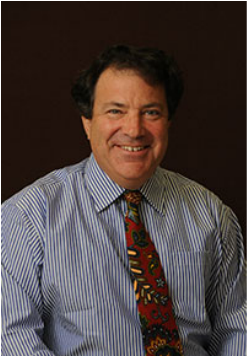Richard Aronson
Rich Aronson and his lab group study climate change and its impacts on seafloor communities around the world. They combine ecology, oceanography, climatology, geology, paleontology, and geochemistry to test hypotheses about the impacts of past climatic variations on benthic communities, and they use that information to project how human-generated climate change will alter the face of those communities. Aronson and company are currently focusing on shallow-water coral reefs of the eastern tropical Pacific and deep-sea benthic communities in Antarctica. Their work is funded by grants from the National Science Foundation. October’s Scientist-of-the-month profile focuses on Antarctica.
Aronson’s early paleontological work on Seymour Island, a large, emergent pile of dirt east of the Antarctic Peninsula that is loaded with fossils, revealed that benthic communities changed drastically in the late Eocene, 41 million years ago (Ma). Isotopic analysis of fossil clams showed that sea temperatures declined dramatically at that time. The 41-Ma event was the beginning of the long-term trend of cooling temperatures that resulted in the very-cold polar climate we know today. The temperature drop apparently slowed down predation rates and allowed benthic communities dominated by ophiuroids (brittlestars) and crinoids (sea lilies) to flourish. Those communities were a throwback to benthic communities from the Paleozoic Era, hundreds of millions of years earlier. The cascading effects of cold temperature, therefore, converted modern-style benthic communities into anachronisms with a Paleozoic community structure.
The low-predation, retrograde community structure that arose in the Eocene has persisted in Antarctica to this day. Shell-crushing decapod crustaceans (crabs and lobsters) and elasmobranchs (cartilagenous fish) and teleosts (bony fish) dominate shallow-marine communities everywhere else in the world, but they are excluded from the Antarctic seas by the cold. The top predators in Antarctica are asteroids (starfish) and giant nemerteans (ribbon worms). Because predation pressure is reduced, ophiuroids, crinoids, and other filter-feeders dominate contemporary communities in Antarctica. Now, rapidly warming sea temperatures threaten to reverse those trends and remodernize the benthic communities. We have discovered large, reproductive populations of predatory king crabs on the continental slope off the western Antarctic Peninsula (WAP). They are most abundant at depths of 1100 to1500 meters. Our most recent work has involved using high-dynamic-range cameras to image the Antarctic seafloor and deploying crab traps in the deep sea to collect the king crabs and learn about their population dynamics.
Three primary conclusions have come out of this ongoing research effort:
Aronson’s early paleontological work on Seymour Island, a large, emergent pile of dirt east of the Antarctic Peninsula that is loaded with fossils, revealed that benthic communities changed drastically in the late Eocene, 41 million years ago (Ma). Isotopic analysis of fossil clams showed that sea temperatures declined dramatically at that time. The 41-Ma event was the beginning of the long-term trend of cooling temperatures that resulted in the very-cold polar climate we know today. The temperature drop apparently slowed down predation rates and allowed benthic communities dominated by ophiuroids (brittlestars) and crinoids (sea lilies) to flourish. Those communities were a throwback to benthic communities from the Paleozoic Era, hundreds of millions of years earlier. The cascading effects of cold temperature, therefore, converted modern-style benthic communities into anachronisms with a Paleozoic community structure.
The low-predation, retrograde community structure that arose in the Eocene has persisted in Antarctica to this day. Shell-crushing decapod crustaceans (crabs and lobsters) and elasmobranchs (cartilagenous fish) and teleosts (bony fish) dominate shallow-marine communities everywhere else in the world, but they are excluded from the Antarctic seas by the cold. The top predators in Antarctica are asteroids (starfish) and giant nemerteans (ribbon worms). Because predation pressure is reduced, ophiuroids, crinoids, and other filter-feeders dominate contemporary communities in Antarctica. Now, rapidly warming sea temperatures threaten to reverse those trends and remodernize the benthic communities. We have discovered large, reproductive populations of predatory king crabs on the continental slope off the western Antarctic Peninsula (WAP). They are most abundant at depths of 1100 to1500 meters. Our most recent work has involved using high-dynamic-range cameras to image the Antarctic seafloor and deploying crab traps in the deep sea to collect the king crabs and learn about their population dynamics.
Three primary conclusions have come out of this ongoing research effort:
- The predatory king crabs reduce populations of their invertebrate prey, including ophiuroids, echinoids (sea urchins), and gastropods (snails) on the continental slope off the WAP.
- The king crabs are already as shallow as 750 m. Because of rapid warming, the waters over the outer continental shelf are already suitable for the king crabs to expand their depth-range. With the shelf-break at 550 m, they do not have very far to go before they are on the outer continental shelf.
- If and when they arrive, the king crabs will threaten populations of endemic species of invertebrates and could substantially alter the composition of benthic communities on the Antarctic shelf.
Publications
|
Article of the month• Robert T. Paine Food Web Complexity and Species Diversity The American Naturalist, Vol. 100, No. 910. (Jan. - Feb., 1966), pp. 65-75.
|

